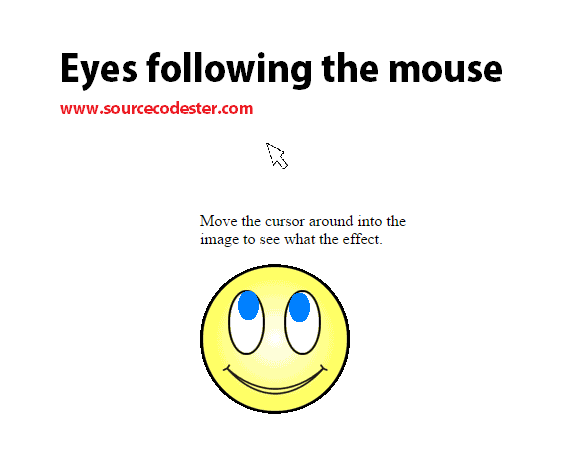Eyes following the mouse using Javascript
Submitted by jaredgwapo on Thursday, January 28, 2016 - 12:01.
Language
In this tutorial, I am going to teach you how to make a xavier eye or eyes following the eye using javascript. Just follow the instructions below.
Congratulations, you have finally created xavier eyes or eyes following mouse that you can use in your systems or projects. For comment and suggestions, feel free to comment below or email me at [email protected]
Instructions
Writing our javascript code and name it as jseyes.js
- /* jseyes.js
- The classic Xeyes in JavaScript
- (c) PROPIX Ltd, Written by Pintér Gábor
- Székesfehérvár, Kriványi u. 15.
- H-8000, HUNGARY
- Tel: +36 30 3489752
- Fax: +36 22 304326
- Email: [email protected]
- Web: http://www.propix.hu
- Revisions:
- V1.0 10/14/2001 Original release
- V1.1 02/20/2008: Updated by JavaScriptKit.com to work in the latest browsers (IE7, FF etc)
- Usage:
- 1. Include this file from the head of your page
- 2. Define parameters or accept the defaults
- 3. Insert the image
- This script requires Internet Explorer 5+ or Nescape Navigator 6+! In other browsers it does nothing.
- 1. Include jseyes.js from the head of your page
- Insert the following line into the head of your page:
- <script src="jseyes.js"></script>
- 2. Define parameters
- You can accept the defaults or assign new values to these variables:
- jseyesimg="jseyes.gif"
- The main image. Please do not edit.
- jseyeimg="jseyeblue.gif"
- The image of the eye. Must be a 21x29 solid ellipse with transparent background.
- 4. Insert the image
- Call jseyes() where you want to see the image:
- <script>
- jseyes();
- </script>
- Or call jseyes(x, y) to show the image at absolute position:
- <script>
- jseyes(100,100);
- </script>
- Example: http://www.propix.hu/www/jseyes/jseyes.html
- */
- // Defaults
- var jseyesimg="images/jseyes.gif";
- var jseyeimg="images/jseyeblue.gif";
- var jseyeslink="http://www.javascriptkit.com";
- // Internal
- var jseyeso=null, jseye1=null, jseye2=null;
- var standardbody=(document.compatMode=="CSS1Compat")? document.documentElement : document.body //create reference to common "body" across doctypes
- // General utils
- // Find object by name or id
- function jseyesobj(id) {
- var i, x;
- x= document[id];
- if (!x && document.getElementById) x= document.getElementById(id);
- for (i=0; !x && i<document.forms.length; i++) x= document.forms[i][id];
- return(x);
- }
- // Move eyes
- function jseyesmove(x, y) {
- var ex, ey, dx, dy;
- if (jseyeso && jseye1 && jseye2 && jseyeso.style) {
- ex=jseyeso.offsetLeft+46; ey=jseyeso.offsetTop+58;
- dx=x-ex; dy=y-ey;
- r=(dx*dx/49+dy*dy/289<1) ? 1 : Math.sqrt(49*289/(dx*dx*289+dy*dy*49));
- jseye1.style.left= r*dx+36.5+'px'; jseye1.style.top= r*dy+44+'px';
- ex+=56; dx-=56;
- r=(dx*dx/49+dy*dy/289<1) ? 1 : Math.sqrt(49*289/(dx*dx*289+dy*dy*49));
- jseye2.style.left= r*dx+92.5+'px'; jseye2.style.top= r*dy+44+'px';
- }
- }
- // Main
- function jseyes() {
- var img;
- var x, y, a=false;
- if (arguments.length==2) {
- x= arguments[0];
- y= arguments[1];
- a= true;
- }
- img= "<div id='jseyeslayer' style='position:"+
- (a ? "absolute; left:"+x+"; top:"+y : "relative")+
- "; z-index:5; width:150; height:150 overflow:hidden'>"+
- "<div id='jseye1' style='position:absolute; left:36; top:44; z-index:6; width:21; height:29'>"+
- "<img src='"+jseyeimg+"' width=21 height=29 onClick=\"location.href='"+jseyeslink+"'\">"+
- "</div>"+
- "<div id='jseye2' style='position:absolute; left:92; top:44; z-index:6; width:21; height:29'>"+
- "<img src='"+jseyeimg+"' width=21 height=29 onClick=\"location.href='"+jseyeslink+"'\">"+
- "</div>"+
- "<img src='"+jseyesimg+"' width=150 height=150 onClick=\"location.href='"+jseyeslink+"'\">"+
- "</div>";
- document.write(img);
- jseyeso=jseyesobj('jseyeslayer');
- jseye1=jseyesobj('jseye1');
- jseye2=jseyesobj('jseye2');
- document.onmousemove=jseyesmousemove;
- }
- // Mouse move events
- function jseyesmousemove(e) {
- var mousex=(e)? e.pageX : event.clientX+standardbody.scrollLeft
- var mousey=(e)? e.pageY : event.clientY+standardbody.scrollTop
- jseyesmove(mousex, mousey);
- //return(false);
- }
Writing our html code
Note: Don't forget to link the javascript code named jseyes.js inside the head tag.- <!DOCTYPE html>
- <head>
- <title>
- Xavier Eye
- </title>
- <style type="text/css">
- #styl {
- float: left;
- margin-left: 580px;
- margin-top: 200px;
- }
- </style>
- </head>
- <body>
- <div id="styl">
- <p>
- Move the cursor around into the<br /> image to see what the effect.
- </p>
- <script>
- jseyes();
- </script>
- </div>
- </body>
- </html>
Note: Due to the size or complexity of this submission, the author has submitted it as a .zip file to shorten your download time. After downloading it, you will need a program like Winzip to decompress it.
Virus note: All files are scanned once-a-day by SourceCodester.com for viruses, but new viruses come out every day, so no prevention program can catch 100% of them.
FOR YOUR OWN SAFETY, PLEASE:
1. Re-scan downloaded files using your personal virus checker before using it.
2. NEVER, EVER run compiled files (.exe's, .ocx's, .dll's etc.)--only run source code.

